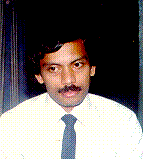
WELCOME TO SARAN'S PAGE

I am Arvind Kumar Saran. I hail from Allahabad, a holy city of confluence of rivers Ganga, Yamuna and Saraswati, situated in the Eastern Uttar Pradesh state of India.
I had my formal education in Allahabad and obtained the Masters degree in Engineering (M.Tech) from the Indian Institute of Technology(IIT), New Delhi in the year 1985. My field of specialisation is Fiber communication and Signal processing.
I joined the National Institute of Oceanography (NIO) in 1986. For a year. I worked for the Marine Archaeological Centre, NIO, Goa, as the Scientist ' B (instrumentation). Thereafter, in 1987, I was associated with the Ocean Acoustic Tomography Group in the same Institute. Since then, I am working with this multi-disciplinary area of study. At NIO, Ocean Acoustic Tomography (OAT) studies have been initiated in 1987 under the project `Development of acoustic techniques for collection of real time oceanographic data'. These studies were broadly grouped into: Oceanography, acoustics and instrumentation. The field experiment and development of software for computations formed the major activity. Three oceanographic cruises were conducted in 1987, 1988, and 1989 for collection of environmental oceanographic data, required for acoustic model simulations, prior to the conduct of the field experiment. In all the above cruises my contribution was towards collection of data sets and usage of instruments.
I participated in an experiment which was conducted during April 25- May 15, 1993 to validate the simulated results against the measured acoustic travel times. The results show close agreement between the simulated and the measured sound speed in 1-D and 2-D. The parameters and processes that can be measured/ computed from analysis of acoustic tomography data in the form of travel time of arrivals of acoustic signals involve temperature, salinity, density, currents, pH, vorticity, heat flux, meso-scale eddies, internal waves, barotropic motions, wave spectra, tides, Upwelling etc.
Vorticity is a parameter which has never been measured and is only estimated till now. This parameter is useful one for computing the particle fluxes in the ocean in addition to understanding the long-term trends in global warming.
I have also received training in the letters of program towards instrumentation, hardware and software used for the Heard Island experiment at Scripps Institute of Oceanography, USA and International experiment wherein, India, one among the nine countries participated in the Heard Island Feasibility Test by receiving acoustic signals transmitted from the source situated around 7000 km away, in the year 1991.
Currently, studies are underway for integrating tomographic data with measurements from free-drifting sensors, survey ships and conventional instruments moored at sea. Attempts are being made to reduce the cost of tomographic methods, perhaps using drifting buoys positioned with precision by satellite navigation and telemetering data via satellite communication.
![]()